Category: Agriculture
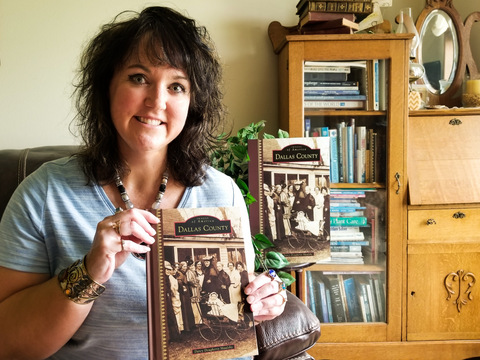
The Hotel Pattee and I are Hosting a Party—And You’re Invited!
What are you doing on Monday evening, Sept. 11? I would like to personally invite you to Perry to the historic Hotel Pattee at 7 p.m. for the debut of Dallas County, my latest non-fiction Iowa history book. It’s all here—drama, crime (Bonnie and Clyde), politics (Dallas County made President Harry Truman the original Comeback Kid), romance, tragedy, mystery, action, adventure, sports, food, agriculture, architecture, science, business, biography, comics and more—all told through more than 100 vintage photos and short stories in 10 chapters.
During this fun event at the hotel (click here for all the details!), I’ll take you on a time-traveling virtual tour of fun, surprising and sometimes shocking Dallas County history highlights. Stick around for the book signing after the program, and then stroll through the iconic Hotel Pattee to tour some of the guest rooms that will be open that evening. Every room in this grand boutique hotel features unique décor that tells the stories of Perry, Dallas County and Iowa history.
I’ve specifically asked that the luxurious Louis Armstrong Suite be open that evening. (In case you’re wondering about the Iowa connection, Louis Armstrong performed in Dallas County in 1954 at the legendary Lake Robbins Ballroom near Woodward and stayed at the Hotel Pattee.)
If nothing else, stop by on Sept. 11 for the homemade cookies the Hotel Pattee’s culinary team is preparing with some of my favorite recipes!
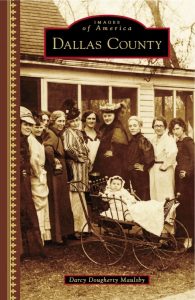 Explore forgotten Iowa history
Explore forgotten Iowa history
I am so excited to bring you this new hardcover, illustrated book, which is the first in-depth, non-fiction history of Dallas County, Iowa, in nearly 80 years!
No Iowa county has influenced American history more than Dallas County. It propelled Harry Truman to an unlikely victory in the 1948 presidential campaign, following a fiery speech he delivered to 100,000 farmers on a sweltering September day at the National Plowing Match near Dexter. Just 15 years earlier, a shoot-out near Dexfield Park marked the beginning of the end for infamous outlaws Bonnie and Clyde and the notorious Barrow Gang.
Dallas County, located just west of Des Moines, has produced several major-league baseball players (among them Bob Feller and Hal Manders), a US congressman (David Young), and Nile Kinnick, the 1939 Heisman Trophy winner and University of Iowa football legend whose grandfather George Clarke, of Adel, served as Iowa’s governor from 1913 to 1917.
Today, Dallas County is one of the fastest-growing counties in America and remains a region of opportunity with a rich heritage of small-town living, farming, coal mining, and the immigrant experience.
My 128-page book from Arcadia Publishing (order signed copies here) is filled with intriguing black-and-white, vintage photos on nearly every page, along with stories from Adel, Perry, Waukee, Granger, Woodward, Dexter, Linden, Minburn, Dawson, Dallas Center, Van Meter, Redfield, Bouton, surrounding rural areas and ghost towns.
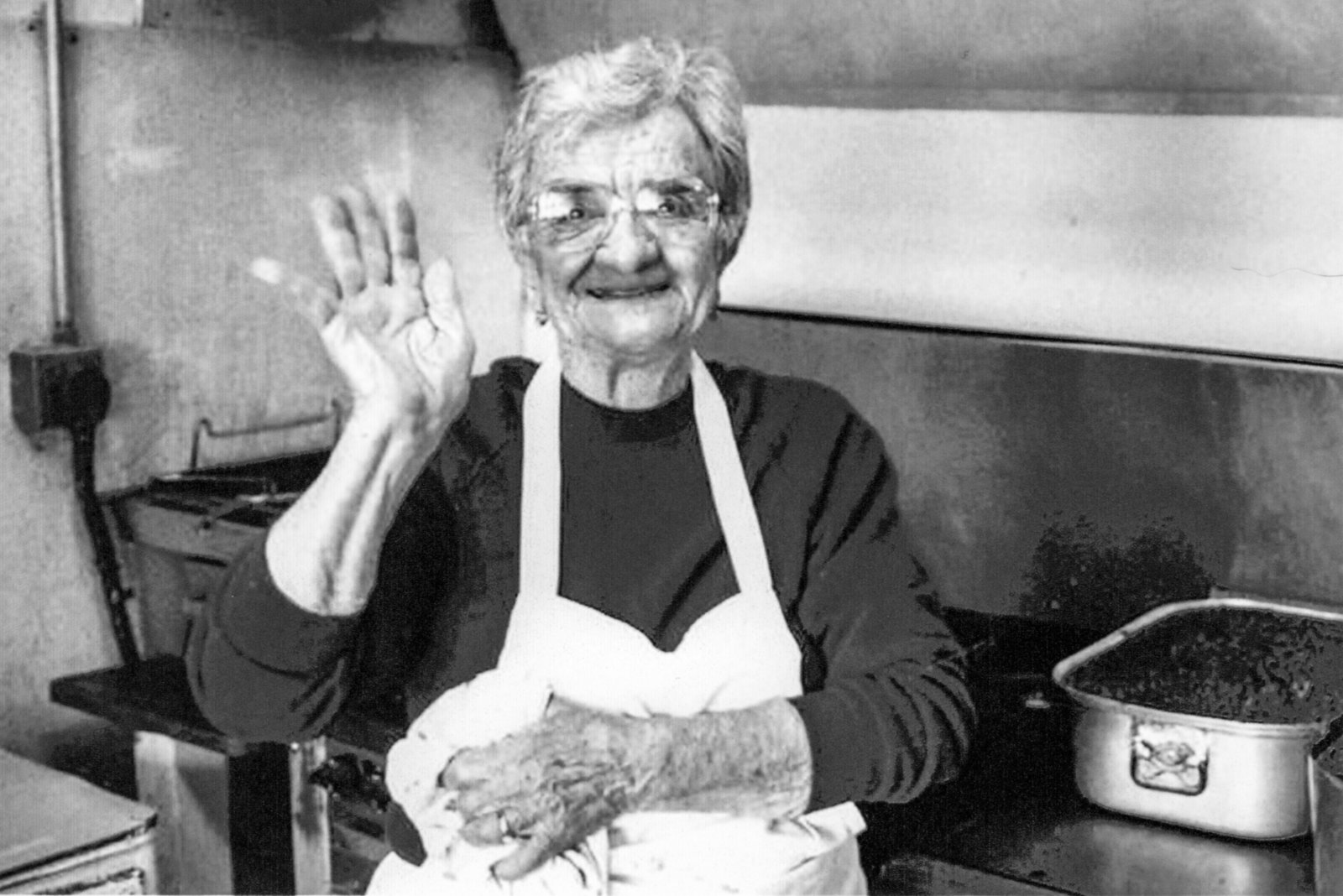
Alice Nizzi, owner of Alice’s Spaghettiland, an Italian restaurant open from 1947 – 2004 in Waukee. Source: Waukee Area Historical Society
Here’s a quick list of highlights that make this Dallas County book unique:
1. Many of the images have been donated from private collections.
2. In the early 20th century, Dallas County was one of the biggest coal-mining areas of Iowa. Much of this history, from Waukee to Woodward, is shared in this new Dallas County book. You can also get the inside story in this guest blog post I wrote for Hometown Heritage in Perry.
3. At least two circuses once made Dallas County their home base, including the famous Orton Bros. three-ring circus, where Five generations of the Orton family thrilled audiences for years. The Yankee Robinson Show, a Midwestern traveling circus, made its winter quarters two miles southeast of Granger. The spacious area also provided a place to bury deceased circus elephants. Granger may be the only Iowa town to claim an elephant graveyard.
4. Minburn’s legendary Singing Wheels roller skating show debuted in 1950 and ran through the early 1960s. Local children, high school students from the Minburn Roller Club and adults all participated in the Singing Wheels’ summer performances, which included a new theme every year, eye-catching costumes, and choreographed routines. These shows attracted thousands of people to the Minburn roller skating rink.
5. The Lake Robbins Ballroom, which opened on November 11, 1931, near Woodward, is still a popular entertainment destination and is one of the few remaining ballrooms in Iowa. The legendary Louis Armstrong performed at Lake Robbins in 1954 and stayed at the Hotel Pattee in Perry, where the most luxurious suite in the hotel is named in his honor.
6. Granger became the focal point of a successful New Deal program inspired by Monsignor Luigi Ligutti, who had served Assumption Church in Granger since 1926. Ligutti felt coal camps were an unsuitable environment for children and looked to the land to address the miners’ economic and social challenges. The 225-acre Granger Homesteads, built in 1935, included 50 modern homes, along with approximately four acres each for raising crops and livestock. In 1936, First Lady Eleanor Roosevelt visited the Granger Homesteads and praised the success of the project.
7. The KKK was active in Dallas County, especially Perry, in the early 1920s. Almost 15,000 people witnessed a KKK parade and semi-public meeting in Perry on May 31, 1924.
8. Dallas County is one of the fastest-growing counties in America and remains a region of opportunity with a rich heritage of small-town living, farming, coal mining, and the immigrant experience.
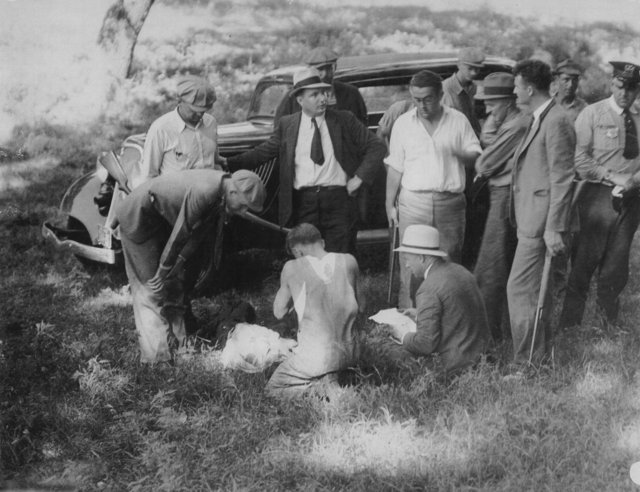
While Bonnie and Clyde escaped, Clyde’s older brother, Buck Barrow (shown lying on the ground), was mortally wounded during a shootout with law enforcement during the early morning hours of July 24, 1933, near Dexfield Park in southern Dallas County. Buck would die a few days later at Kings Daughters Hospital in Perry. Source: Dexter Museum
Click here to order your signed copy today! Priceless memories of Iowa history make a great gift, too.
• Series: Images of America
• Hardcover: 128 pages
• Publisher: Arcadia Publishing (September 4, 2017)
Want more?
Thanks for stopping by. I invite you to read more of my blog posts if you want more more intriguing Iowa stories and history, along with Iowa food, recipes and tips to make you a better communicator.
If you like what you see and want to be notified when I post new stories, be sure to click on the “subscribe to blog updates/newsletter” button at the top of this page. Feel free to share this information with friends and colleagues who might be interested, too.
If you’re hungry for more stories of Iowa history, check out my top-selling “Culinary History of Iowa: Sweet Corn, Pork Tenderloins, Maid-Rites and More” book from The History Press, as well as my Calhoun County” book from Arcadia Publishing, which showcases the history of small-town and rural Iowa. Order your signed copies today! Iowa postcards are available in my online store, too.
Let’s stay in touch. I’m at darcy@darcymaulsby.com, and yettergirl@yahoo.com.
About me:
Some people know me as Darcy Dougherty Maulsby, while others call me Yettergirl. I grew up on a Century Farm between Lake City and Yetter and am proud to call Calhoun County, Iowa, home. I’m an author, writer, marketer, business owner and entrepreneur who specializes in agriculture. Learn more at www.darcymaulsby.com.
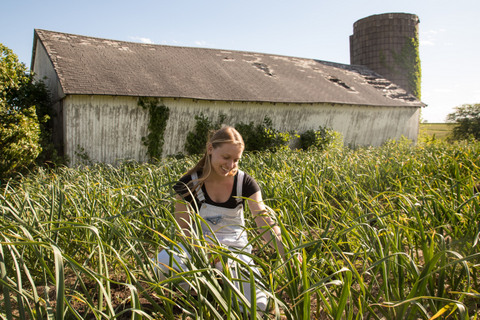
Ultra-Local Eating: Jennifer Miller Guides CSA, Iowa Food Cooperative
Jennifer Miller could hardly believe the question. “When will your bananas be ready?” inquired a central Iowa woman who was buying fresh produce through Miller’s Clarion Sage market garden and community supported agriculture (CSA) business near Waukee.
“People are disconnected from where their food comes from,” said Miller, 30, who noted the woman seeking locally-grown bananas is a well-educated business professional. “I’ve even had people look at our heirloom tomatoes and say, ‘I don’t want those,’ because they think they are GMOs.’”
This disconnect isn’t all that foreign to Miller, who grew up in Highland Park, Illinois, a northern suburb of Chicago. “I had no contact with agriculture in Highland Park,” said Miller, who serves as the Iowa Food Cooperative’s member services coordinator.
Miller did have a connection with Iowa, though, through her paternal grandparents, who lived in the Clarion/Rowan area. Her decision to move to Iowa in 2010 was spurred, in part, by a health challenge and new-found passion for healthy eating.
Miller was diagnosed a number of years ago with celiac disease, a serious autoimmune disorder where consuming gluten can damage the small intestine. “I started caring more about cooking and healthy recipes, because I just wanted to feel better,” said Miller, whose gluten-free and vegan recipes on her blog caught the attention of Martha Stewart Living editors, who invited her to develop recipes for them. “That’s what got me into food and agriculture.”
Food can be so much more interesting
After moving to Iowa, Miller got involved with community gardens in the Des Moines area and became a marketing/communications specialist Iowa Food Cooperative, which operates like an online farmers market. In 2013, Miller and her partner, Cody Kilgore, moved to an acreage on the southwest edge of Waukee’s city limits in Van Meter Township so they could operate their own farm.
“It felt like coming full circle,” said Kilgore, who was raised in rural Missouri, worked in the corporate world for nearly 30 years and was ready for a career switch.
 The couple planted garlic in the fall of 2013 to start their Clarion Sage market garden. The goal? “We believe in ultra-local and want to feed the community around us,” said Miller, who noted that Clarion Sage primarily serves families within a five-mile radius in southern Dallas County.
The couple planted garlic in the fall of 2013 to start their Clarion Sage market garden. The goal? “We believe in ultra-local and want to feed the community around us,” said Miller, who noted that Clarion Sage primarily serves families within a five-mile radius in southern Dallas County.
Today, Miller and Kilgore raise a wide array of vegetables and herbs, including lettuce, squash, cabbage, carrots, garlic, tomatoes, cucumbers, peppers, potatoes and more, including heirloom varieties that can’t be found in most stores. They offer an online ordering system for added convenience.
“Food can be so much more interesting,” Miller said. “Whether you’re sharing a family meal, providing snacks for your kids or making a favorite recipe, one thing’s for sure: the starting point for all these is good food.”
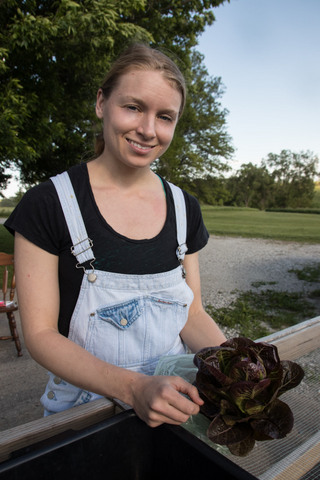
Jennifer Miller displays one of the unique lettuce varieties she grows at Clarion Sage Farm near Waukee.
Six lessons learned about farming and food
As their business evolved, Miller and Kilgore have adjusted their marketing plan to adapt to the often surprising—and sometimes frustrating—buying patterns they’ve observed in the market. The Clarion Sage market garden and CSA have taught them six key lessons, including:
1. Farming is more than production. Raising an abundant crop is just step one, said Miller, who has learned that that marketing and sales are equally important.
2. Mentors matter. “I didn’t grow up gardening, so working for various produce growers in Iowa and beyond taught me so much,” said Miller, who is grateful for leaders like Angela Tedesco who started Turtle Farm near Granger, Jill Beebout from Blue Gate Farm near Chariton and other local food proponents who have mentored her along the way.
3. Buying local adds flavor to life. Clarion Sage’s customers appreciate the “know your farmer” philosophy. Most buyers tend to be in their 30s and 40s with families, or they’re retired and have an interest in good food and time to cook. “Every week we offer our customers about $30 worth of fresh vegetables,” Miller said. “We focus on staple items like lettuce, potatoes, carrots and tomatoes, with the opportunity for more exotic options like stir-fry greens, kale and eggplant.”
4. Catering to consumers can be tricky. While the Clarion Sage CSA is right on Waukee’s doorstep, some consumers don’t want to drive to the farm to pick up vegetables. Some feel they don’t have time, while others don’t like the way the gravel road makes their vehicle dusty. When Miller tried offering delivery, some consumers still rejected this option, citing a lack of time or interest in preparing fresh food. Even full-color newsletters filled with cooking tips and recipes failed to gain much traction with these types of consumers, said Miller, who plans to start selling her produce at the Downtown Farmers’ Market in Des Moines.
5. Urban sprawl is relentless. High-density residential projects are planned for the area near the Clarion Sage’s market garden. “We’re in the bullseye of urban sprawl, which is a challenge,” said Kilgore, who also works as a wedding photographer.
6. Local food pairs well with global flavors. Miller loves ethnic cooking, from Latin American to African. “If you want to add more vegetables to your diet, look to other cultures that don’t have an abundance of meat protein,” said Miller, who encourages people to try vegetables like Cherokee Purple heirloom tomatoes (known for their smoky, complex flavor), fish peppers (which pack more heat), Merlot lettuce (whose dark red leaves offer a mellow flavor) and fingerling potatoes (which taste great fried or roasted).
Food is one of the best parts of life, added Miller, who loves the creativity involved in growing and marketing a crop. “You see a crop through from beginning to end, and you’re producing something that can feed and sustain people. That’s amazing to me.”
Want more?
Thanks for stopping by. I invite you to read more of my blog posts if you want more more intriguing Iowa stories and history, along with Iowa food, recipes and tips to make you a better communicator. If you like what you see and want to be notified when I post new stories, be sure to click on the “subscribe to blog updates/newsletter” button at the top of this page. Feel free to share this information with friends and colleagues who might be interested, too.
If you’re hungry for more stories of Iowa history, check out my top-selling “Culinary History of Iowa: Sweet Corn, Pork Tenderloins, Maid-Rites and More” book from The History Press, as well as my Calhoun County” book from Arcadia Publishing, which showcases the history of small-town and rural Iowa. Order your signed copies today! Iowa postcards are available in my online store, too.
Let’s stay in touch. I’m at darcy@darcymaulsby.com, and yettergirl@yahoo.com.
P.S. Thanks for joining me. I’m glad you’re here.
@Copyright 2017 Darcy Maulsby & Co.
About me:
Some people know me as Darcy Dougherty Maulsby, while others call me Yettergirl. I grew up on a Century Farm between Lake City and Yetter and am proud to call Calhoun County, Iowa, home. I’m an author, writer, marketer, business owner and entrepreneur who specializes in agriculture. Learn more at www.darcymaulsby.com.
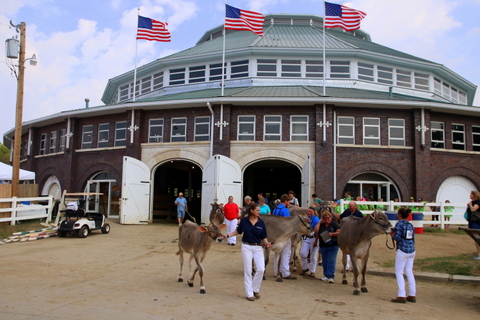
Iconic State Fair Architecture- Historic Buildings Reflect Decades of Memories
The Iowa State Fair is a homecoming for Iowans, and the historic buildings that grace the fairgrounds in Des Moines provide iconic venues for this statewide family reunion. There’s also a lot of surprising history behind many of these structures, from the Agriculture Building to the Livestock Pavilion.
“The Iowa State Fair connects generations of Iowans,” said Iowa Governor Kim Reynolds, who spoke during the opening ceremony of the 2017 Iowa State Fair on August 10. “There are so many wonderful memories and traditions here at the fair, which showcases the best of Iowa’s agricultural and cultural heritage.”
While the first Iowa State Fair was held October 25-27, 1854, in Fairfield, supported by a total operating budget of $323, the fair moved to its present location in 1886.
“The state fair moved to this site in Des Moines after the State Legislature and the City of Des Moines appropriated funds to purchase Calvin and Arminta Thornton’s farm,” said Leo Landis, state curator for the State Historical Society of Iowa, who helped lead an Iowa State Fair walking tour on Aug. 10. “One building original to the Thornton farm remains–Grandfather’s Barn, which is on the far eastern edge of the fairgrounds.”
Livestock Pavilion opened in 1902
Between the time the Fair Board purchased the land in June 1886 and when the fair opened in September 1886, crews constructed 67 buildings. “Of those, Pioneer Hall is the only one that remains today,” said Landis, museum curator at the State Historical Museum.
By the 1900 Iowa State Fair, most of the buildings built for the 1886 fair were still in use. They were beginning to show signs of decay, however, and roofs were particularly bad. It was time for the Iowa State Fair to clean up the fairgrounds.
One of the first new buildings added more than a century ago was the Livestock Pavilion. Back in 1901, more than 650 cattle were shown at the Iowa State Fair – only about 50 less than were shown that year at the International Stock Show at Chicago, Landis said. With future Iowa State Fairs expected to have even more cattle, the Iowa Legislature appropriated $37,000 for a fireproof steel-and-brick stock pavilion, similar to one that had just been constructed at the Illinois State Fairgrounds.
The Livestock Pavilion was the first major brick-and-steel structure built at the Iowa State Fairgrounds. “By constructing buildings out of these materials, the Fair Board gave the fair a sense of permanence and safety at this location,” said Landis, who noted that the new Livestock Pavilion officially opened for the 1902 fair and has been used for stock judging, lectures, entertainment and more for decades.
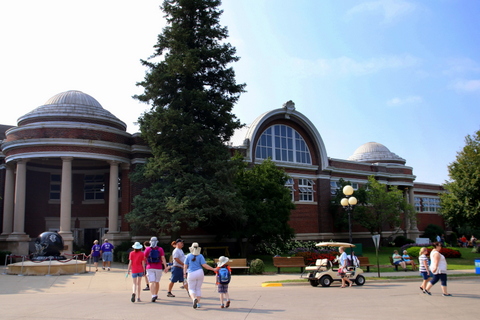
A new Agriculture Building was constructed in time for the 1904 Iowa State Fair. This famous building is home to the beloved Butter Cow. The Agriculture Building is one of the finest examples of Double Jeffersonian architecture remaining in the world.
1904 State Fair showcased new Agriculture Building
A new Agriculture Building came along two years later, in time for the 1904 Iowa State Fair. Located at the intersection of Grand Avenue and Rock Island Avenue, the Agriculture Building was built along the route to and from the State Fair from the Rock Island Railroad depot.
From the beginning, the Agriculture Building has been used as the agricultural, horticultural and dairy building. It’s home to the famous Butter Cow and other butter sculptures, which have been part of the Iowa State Fair since 1911.
“The Homestead,” a well-known farm newspaper of the late 1800s and early 1900s published in Des Moines, touted the new Agriculture Building as “one of the finest structures for exhibiting products of the farm that can be found in the Central West.”
The building’s design was inspired by the Exposition Halls at the Columbian Exposition, the world’s fair held in Chicago in 1893. The Agriculture Building is one of the finest examples of Double Jeffersonian architecture remaining in the world.
“Building a structure of such grand scale – with 33,800 square feet of floor space – suggested to visitors that the Iowa State Fair was an event of both civic and social importance,” said Jessica Rundlett, special projects and outreach coordinator at State Historical Museum of Iowa, who assisted with the Iowa State Fair walking tour.
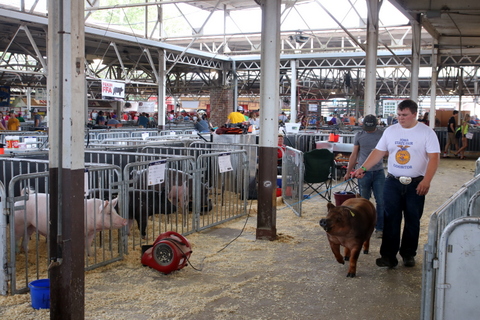
Kyle Andrews with the Wayne FFA chapter exhibited hogs during the 2017 Iowa State Fair. The Swine Barn was built in 1907.
Swine Barn design enhanced ventilation
When a new Swine Barn was constructed for the 1907 Iowa State Fair, the roof covered 185,000 square feet of stalls, exhibition areas and two central show rings that could seat more than 800 people. “The Homestead newspaper said you had to see it to believe its grand size,” Landis said.
The state appropriated $75,000 to build the Swine Barn. The building’s roof profile is designed to provide superior lighting and ventilation. The long open windows at roof level and open exterior walls draw in fresh air. Today you can see the Big Boar at the Swine Barn, as well as the Avenue of Breeds, which is coordinated by the North Polk FFA.
Horse Barn cost $25,000
The Horse Barn was completed in 1912 for $25,000 and renovated in 1929. Measuring 156 feet by 224 feet, the new barn could accommodate 132 draft horses and a like number of ponies, according to the Homestead newspaper. Th article also noted the new barn was equipped with water troughs, wash stands, sanitary feed mangers and automatic hayracks, Landis said.
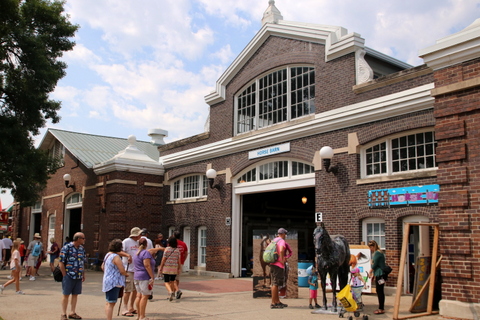
The Horse Barn was completed in 1912 for $25,000 and renovated in 1929.
Cattle Barn named for Iowa farmer
The Iowa State Fair’s building boom of the early twentieth century included the new Cattle Barn, which opened for the 1914 fair. While the original barn could accommodate 108 head of cattle, the barn now has ties for 1,600 cows, thanks to multiple expansions through the years.
Among the early proponents of Iowa’s cattle industry was Iowa Governor William Larrabee of Clermont, Landis noted. Larrabee helped introduced Brown Swiss dairy cattle to Iowa after studying the breed and concluding Brown Swiss were best suited for Iowa’s climate.
Today, the Cattle Barn is named for John Putney, a farmer from Gladbrook who was also a long-time cattle exhibitor, president of the Sale of Champions and beef superintendent. Putney was appointed the first executive director of the Blue Ribbon Foundation, which has raised more than $135 million in the last 25 years to renovate and preserve the Iowa State Fairgrounds.
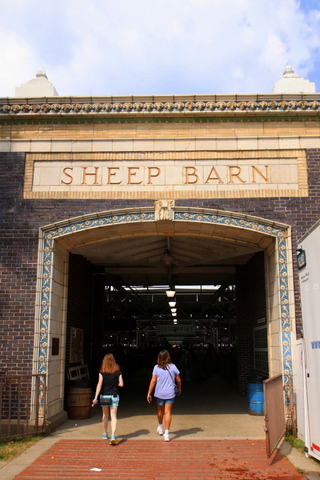
In 1915, the state legislature appropriated $14,000 to build a sheep pavilion. The Sheep Barn opened for the 1917 Iowa State Fair. The building is notable for the detailed terra cotta designs on the east façade, including a row of rams’ heads near the roof.
Sheep Pavilion opened for 1917 fair
During the Golden Age of Agriculture, state funding was available to construct a wide range of livestock barns at the Iowa State Fair. In 1915, the state legislature appropriated $14,000 to build a sheep pavilion. The Sheep Barn opened for the 1917 Iowa State Fair. The building is notable for the detailed terra cotta designs on the east façade, including a row of rams’ heads near the roof.
The legacy lives on
The Iowa State Fairgrounds was listed on the National Register of Historic Places in 1987. It’s a fitting honor for a unique venue filled with many architectural marvels. “The late Bill Wagner, a preservation architect from Iowa, noted that ‘the complex contains a representative collection of almost all architectural styles for most of the past 200 years,’” Landis said.
Historic buildings are just one of the many reasons the Iowa State Fair is the best state fair in the nation, Reynolds said. “I’m extraordinarily proud of this tradition. Remember—nothing compares to our great Iowa State Fair!”
Take a virtual tour
The Iowa State Fair Walking Tour can be found on the Iowa Culture App. Either download the app, or log onto dcaapp.com. Click on the featured tour “Star” button on the right and look for the “Iowa State Fair tour.”
Want more?
Thanks for stopping by. I invite you to read more of my blog posts if you want more more intriguing Iowa stories and history, along with Iowa food, recipes and tips to make you a better communicator. If you like what you see and want to be notified when I post new stories, be sure to click on the “subscribe to blog updates/newsletter” button at the top of this page. Feel free to share this information with friends and colleagues who might be interested, too.
If you’re hungry for more stories of Iowa history, check out my top-selling “Culinary History of Iowa: Sweet Corn, Pork Tenderloins, Maid-Rites and More” book from The History Press, as well as my Calhoun County” book from Arcadia Publishing, which showcases the history of small-town and rural Iowa. Order your signed copies today! Iowa postcards are available in my online store, too.
Let’s stay in touch. I’m at darcy@darcymaulsby.com, and yettergirl@yahoo.com.
P.S. Thanks for joining me. I’m glad you’re here.
@Copyright 2017 Darcy Maulsby & Co.
About me:
Some people know me as Darcy Dougherty Maulsby, while others call me Yettergirl. I grew up on a Century Farm between Lake City and Yetter and am proud to call Calhoun County, Iowa, home. I’m an author, writer, marketer, business owner and entrepreneur who specializes in agriculture. Learn more at www.darcymaulsby.com.

Iconic State Fair Architecture: Historic Buildings Reflect Decades of Memories
The Iowa State Fair is a homecoming for Iowans, and the historic buildings that grace the fairgrounds in Des Moines provide iconic venues for this statewide family reunion. There’s also a lot of surprising history behind many of these structures, from the Agriculture Building to the Livestock Pavilion.
“The Iowa State Fair connects generations of Iowans,” said Iowa Governor Kim Reynolds, who spoke during the opening ceremony of the 2017 Iowa State Fair on August 10. “There are so many wonderful memories and traditions here at the fair, which showcases the best of Iowa’s agricultural and cultural heritage.”
While the first Iowa State Fair was held October 25-27, 1854, in Fairfield, supported by a total operating budget of $323, the fair moved to its present location in 1886.
“The state fair moved to this site in Des Moines after the State Legislature and the City of Des Moines appropriated funds to purchase Calvin and Arminta Thornton’s farm,” said Leo Landis, state curator for the State Historical Society of Iowa, who helped lead an Iowa State Fair walking tour on Aug. 10. “One building original to the Thornton farm remains–Grandfather’s Barn, which is on the far eastern edge of the fairgrounds.”
Livestock Pavilion opened in 1902
Between the time the Fair Board purchased the land in June 1886 and when the fair opened in September 1886, crews constructed 67 buildings. “Of those, Pioneer Hall is the only one that remains today,” said Landis, museum curator at the State Historical Museum.
By the 1900 Iowa State Fair, most of the buildings built for the 1886 fair were still in use. They were beginning to show signs of decay, however, and roofs were particularly bad. It was time for the Iowa State Fair to clean up the fairgrounds.
One of the first new buildings added more than a century ago was the Livestock Pavilion. Back in 1901, more than 650 cattle were shown at the Iowa State Fair – only about 50 less than were shown that year at the International Stock Show at Chicago, Landis said. With future Iowa State Fairs expected to have even more cattle, the Iowa Legislature appropriated $37,000 for a fireproof steel-and-brick stock pavilion, similar to one that had just been constructed at the Illinois State Fairgrounds.
The Livestock Pavilion was the first major brick-and-steel structure built at the Iowa State Fairgrounds. “By constructing buildings out of these materials, the Fair Board gave the fair a sense of permanence and safety at this location,” said Landis, who noted that the new Livestock Pavilion officially opened for the 1902 fair and has been used for stock judging, lectures, entertainment and more for decades.

A new Agriculture Building was constructed in time for the 1904 Iowa State Fair. This famous building is home to the beloved Butter Cow. The Agriculture Building is one of the finest examples of Double Jeffersonian architecture remaining in the world.
1904 State Fair showcased new Agriculture Building
A new Agriculture Building came along two years later, in time for the 1904 Iowa State Fair. Located at the intersection of Grand Avenue and Rock Island Avenue, the Agriculture Building was built along the route to and from the State Fair from the Rock Island Railroad depot.
From the beginning, the Agriculture Building has been used as the agricultural, horticultural and dairy building. It’s home to the famous Butter Cow and other butter sculptures, which have been part of the Iowa State Fair since 1911.
“The Homestead,” a well-known farm newspaper of the late 1800s and early 1900s published in Des Moines, touted the new Agriculture Building as “one of the finest structures for exhibiting products of the farm that can be found in the Central West.”
The building’s design was inspired by the Exposition Halls at the Columbian Exposition, the world’s fair held in Chicago in 1893. The Agriculture Building is one of the finest examples of Double Jeffersonian architecture remaining in the world.
“Building a structure of such grand scale – with 33,800 square feet of floor space – suggested to visitors that the Iowa State Fair was an event of both civic and social importance,” said Jessica Rundlett, special projects and outreach coordinator at State Historical Museum of Iowa, who assisted with the Iowa State Fair walking tour.

Kyle Andrews with the Wayne FFA chapter exhibited hogs during the 2017 Iowa State Fair. The Swine Barn was built in 1907.
Swine Barn design enhanced ventilation
When a new Swine Barn was constructed for the 1907 Iowa State Fair, the roof covered 185,000 square feet of stalls, exhibition areas and two central show rings that could seat more than 800 people. “The Homestead newspaper said you had to see it to believe its grand size,” Landis said.
The state appropriated $75,000 to build the Swine Barn. The building’s roof profile is designed to provide superior lighting and ventilation. The long open windows at roof level and open exterior walls draw in fresh air. Today you can see the Big Boar at the Swine Barn, as well as the Avenue of Breeds, which is coordinated by the North Polk FFA.
Horse Barn cost $25,000
The Horse Barn was completed in 1912 for $25,000 and renovated in 1929. Measuring 156 feet by 224 feet, the new barn could accommodate 132 draft horses and a like number of ponies, according to the Homestead newspaper. Th article also noted the new barn was equipped with water troughs, wash stands, sanitary feed mangers and automatic hayracks, Landis said.

The Horse Barn was completed in 1912 for $25,000 and renovated in 1929.
Cattle Barn named for Iowa farmer
The Iowa State Fair’s building boom of the early twentieth century included the new Cattle Barn, which opened for the 1914 fair. While the original barn could accommodate 108 head of cattle, the barn now has ties for 1,600 cows, thanks to multiple expansions through the years.
Among the early proponents of Iowa’s cattle industry was Iowa Governor William Larrabee of Clermont, Landis noted. Larrabee helped introduced Brown Swiss dairy cattle to Iowa after studying the breed and concluding Brown Swiss were best suited for Iowa’s climate.
Today, the Cattle Barn is named for John Putney, a farmer from Gladbrook who was also a long-time cattle exhibitor, president of the Sale of Champions and beef superintendent. Putney was appointed the first executive director of the Blue Ribbon Foundation, which has raised more than $135 million in the last 25 years to renovate and preserve the Iowa State Fairgrounds.

In 1915, the state legislature appropriated $14,000 to build a sheep pavilion. The Sheep Barn opened for the 1917 Iowa State Fair. The building is notable for the detailed terra cotta designs on the east façade, including a row of rams’ heads near the roof.
Sheep Pavilion opened for 1917 fair
During the Golden Age of Agriculture, state funding was available to construct a wide range of livestock barns at the Iowa State Fair. In 1915, the state legislature appropriated $14,000 to build a sheep pavilion. The Sheep Barn opened for the 1917 Iowa State Fair. The building is notable for the detailed terra cotta designs on the east façade, including a row of rams’ heads near the roof.
The legacy lives on
The Iowa State Fairgrounds was listed on the National Register of Historic Places in 1987. It’s a fitting honor for a unique venue filled with many architectural marvels. “The late Bill Wagner, a preservation architect from Iowa, noted that ‘the complex contains a representative collection of almost all architectural styles for most of the past 200 years,’” Landis said.
Historic buildings are just one of the many reasons the Iowa State Fair is the best state fair in the nation, Reynolds said. “I’m extraordinarily proud of this tradition. Remember—nothing compares to our great Iowa State Fair!”
Take a virtual tour
The Iowa State Fair Walking Tour can be found on the Iowa Culture App. Either download the app, or log onto dcaapp.com. Click on the featured tour “Star” button on the right and look for the “Iowa State Fair tour.”
Want more?
Thanks for stopping by. I invite you to read more of my blog posts if you want more more intriguing Iowa stories and history, along with Iowa food, recipes and tips to make you a better communicator. If you like what you see and want to be notified when I post new stories, be sure to click on the “subscribe to blog updates/newsletter” button at the top of this page. Feel free to share this information with friends and colleagues who might be interested, too.
If you’re hungry for more stories of Iowa history, check out my top-selling “Culinary History of Iowa: Sweet Corn, Pork Tenderloins, Maid-Rites and More” book from The History Press, as well as my Calhoun County” book from Arcadia Publishing, which showcases the history of small-town and rural Iowa. Order your signed copies today! Iowa postcards are available in my online store, too.
Let’s stay in touch. I’m at darcy@darcymaulsby.com, and yettergirl@yahoo.com.
P.S. Thanks for joining me. I’m glad you’re here.
@Copyright 2017 Darcy Maulsby & Co.
About me:
Some people know me as Darcy Dougherty Maulsby, while others call me Yettergirl. I grew up on a Century Farm between Lake City and Yetter and am proud to call Calhoun County, Iowa, home. I’m an author, writer, marketer, business owner and entrepreneur who specializes in agriculture. Learn more at www.darcymaulsby.com.

Behind the Scene at Iowa’s Own Market to Market
If you’ve lived in Iowa, especially on a farm, anytime from the mid-1970s to today, there’s a good chance your family has tuned into Iowa Public Television (IPT) on Friday nights (or possibly Sunday afternoons) to watch Market to Market. That’s how it has been at my family’s Century Farm, and it’s a tradition that makes me proud to be an Iowan.
After all, Iowa is the home of Market to Market, which has covered issues affecting agriculture, from global trade conflicts to environmental controversies to changing technology, for more than four decades. Today, the weekly news segments and market commentary are geared towards the nearly 60 million people who live and work in rural America.
 Even when I was too young to really know what Market to Market was all about, I could always identify the show by its music. I didn’t know the ending theme song was “Buy for Me the Rain” by the Nitty Gritty Dirt Band. I just called it the Market to Market song, and I’m glad it’s still part of the show.
Even when I was too young to really know what Market to Market was all about, I could always identify the show by its music. I didn’t know the ending theme song was “Buy for Me the Rain” by the Nitty Gritty Dirt Band. I just called it the Market to Market song, and I’m glad it’s still part of the show.
History and tradition are part of Market to Market, the longest-running TV show of its kind. The first episode of Market to Market debuted on October 24, 1975, on IPT. Back then, the show was called “Farm Digest,” I learned from Dave Miller, a senior producer/director who has worked at IPT more than 33 years.
I met Miller in July when my family and I toured the IPT studio in Johnston. The tour came about after Josh Buettner, an IPT producer/director, visited our farm a few years ago to shoot a segment on water quality. He mentioned that if I’d ever like to watch a taping of Market to Market, he could arrange it.
I thought it would be cool to take him up on this unique opportunity, since my family has been Market to Market fans for decades. When we pulled up outside the gleaming white studio on a hot Friday afternoon in July, we felt like royalty as IPT staff members greeted us at the front door and welcomed us into the bright lobby. When we were ushered back to the control room around 4 p.m., I was amazed by how dark the rest of the building is.
As we took our seats around the edge of the room, it wasn’t long before a staff member called out “We’re 15 seconds away. Stand by everybody, stand by!”
At the word “go,” vibrant images flashed onto row after row of computer monitors that glowed against the black surroundings. “Thunder!” called out one producer as the famous Market to Market logo shot onto the screens.
About 10 minutes later, we were ushered across the hall into the cavernous main studio, where Market to Market host Mike Pearson sat at a spacious desk and prepared to interview analyst Tomm Pfitzenmaier. As the red digital numbers counted down on a monitor near us, it seemed surreal to watch the interview in progress, both in person just a few feet from us and on a TV monitor right in front of us.
 As I took it all in, from the thick power cords snaking across the floor to the huge cameras to lights of all types hanging from the black ceilings, I wondered what the technology was like back when Chet Randolph hosted the show. Dave Miller filled in some of the gaps. “I can remember when we had to run the tapes to the bus station in Des Moines so they could be put on an express bus to Lincoln, Nebraska, which had the nearest uplink,” he noted.
As I took it all in, from the thick power cords snaking across the floor to the huge cameras to lights of all types hanging from the black ceilings, I wondered what the technology was like back when Chet Randolph hosted the show. Dave Miller filled in some of the gaps. “I can remember when we had to run the tapes to the bus station in Des Moines so they could be put on an express bus to Lincoln, Nebraska, which had the nearest uplink,” he noted.
Wow, times have definitely changed. Still, one thing hasn’t changed—the Market to Market team’s commitment to share timely news and ag-related feature stories each week. When the show wrapped up and I heard the familiar notes of “Buy for Me the Rain,” it was amazing to think that the segments recorded right in front of our eyes would be broadcast to 20 states from California to Tennessee in just a few hours—and it all starts right here in Iowa.
This piece originally appeared on Farm News.
Want more?
Thanks for stopping by. I invite you to read more of my blog posts if you want more more intriguing Iowa stories and history, along with Iowa food, recipes and tips to make you a better communicator. If you like what you see and want to be notified when I post new stories, be sure to click on the “subscribe to blog updates/newsletter” button at the top of this page. Feel free to share this information with friends and colleagues who might be interested, too.
If you’re hungry for more stories of Iowa history, check out my top-selling “Culinary History of Iowa: Sweet Corn, Pork Tenderloins, Maid-Rites and More” book from The History Press, as well as my Calhoun County” book from Arcadia Publishing, which showcases the history of small-town and rural Iowa. Order your signed copies today! Iowa postcards are available in my online store, too.
Let’s stay in touch. I’m at darcy@darcymaulsby.com, and yettergirl@yahoo.com.
P.S. Thanks for joining me. I’m glad you’re here.
@Copyright 2017 Darcy Maulsby & Co.
About me:
Some people know me as Darcy Dougherty Maulsby, while others call me Yettergirl. I grew up on a Century Farm between Lake City and Yetter and am proud to call Calhoun County, Iowa, home. I’m an author, writer, marketer, business owner and entrepreneur who specializes in agriculture. Learn more at www.darcymaulsby.com.
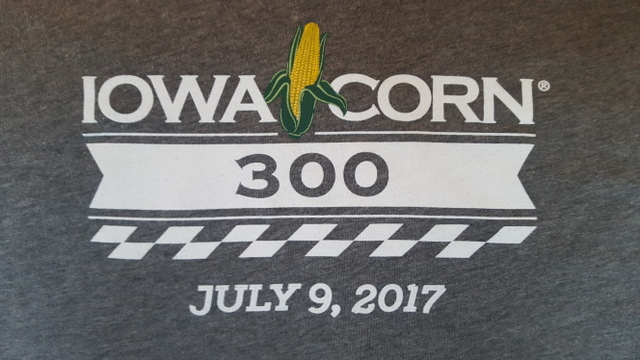
Ethanol:Passion by the Gallon
What drives you? When I stopped by the Iowa Corn 300 at the Iowa Speedway on July 9, ethanol wasn’t the only driving force as Indy cars roared past the grandstand.
While the cars shot around the oval at speeds over 200 miles per hour, covering the length of a football field in less than a second, I was also struck by the passion that drives today’s corn-grower leaders. It’s a spirit fueled by a strong sense of history and a focus on the future as the Iowa Corn Growers Association (ICGA) celebrates its 50th anniversary.
“Long before the Iowa Corn 300, the whole ethanol industry got started by visionaries who were tired of being captive to low corn prices and wanted to find a way to write their own ticket,” said Mark Heckman, a farmer from West Liberty and chairman of the Iowa Corn Promotion Board (ICPB) who visited with me during the race.
Those visionary farmers included Thurman Gaskill, a Corwith farmer who served as ICPB’s first president in 1978. When this future ICGA president and state senator pumped Iowa’s first tank of corn-based ethanol (called gasohol back then) in the eastern Iowa town of Clarence, many people viewed this new fuel as just a corn-fed gimmick.
Corn growers like Gaskill were undeterred in their quest to provide a solution to the 1970s energy crisis and low corn prices.
Iowa Corn leaders found five filling stations willing to sell gasoline mixed with 10 percent ethanol in Clarence, Cumberland, Osage, Peterson and Fort Dodge. The fuel cost about 70 cents per gallon, and customers drove away with a free “This car powered by Gasohol” bumper sticker. The Fort Dodge station sold about 350 gallons in the first hour, mostly to farmers who pulled up in their pickups, according to ICGA.
Thanks to tireless efforts by Iowa corn grower leaders, ethanol grew from a dream into a reality. Here’s a look back with ICGA’s timeline:
1982: The U.S. Environmental Protection Agency (EPA) announces standards to reduce lead content in gasoline, paving the way for ethanol’s use as a replacement octane booster.
1985: The Ford Motor Company rolls out the first vehicles designed to run on unleaded gasoline.
1988: Iowa Governor Terry Branstad orders all vehicles in the state government’s fleet to run on ethanol-blended fuel.
1990: The federal Clean Air Act is amended to mandate the use of clean-burning additives to fuel, while the Iraqi invasion of Kuwait focuses attention on U.S. oil supplies and the importance of home-grown ethanol.
1996: The ICPB establishes Iowa’s first E-85 (85 percent ethanol) fueling station in West Burlington. (I admit—I love my flex-fuel SUV and always look for E-85 pumps when I’m on the road.)
1999: The ICPB hosts workshops with ethanol plant representatives and other ethanol supporters to develop new farmer-owned ethanol ventures.
2004: Iowa becomes the #1 ethanol-producing state for the first time.
2005: Congress creates the Renewable Fuel Standard (RFS) to help reduce America’s dependence on foreign oil, cut greenhouse gas emissions and spur economic development, especially in rural America.
2007: Iowa Corn develops a partnership with the new Iowa Speedway for the Iowa Corn Indy 250 (now the Iowa Corn 300) to promote higher blends of corn-ethanol fuels in high-performing engines.
2008: Corn prices soar to historic levels, triggering the food-versus fuel ethanol debate as food prices also spike.
2011: NASCAR adopts the use of E-15.
2017: More than 15 billion gallons of ethanol are produced annually in America, and ethanol is used in more than 95 percent of the fuel sold in America.
While I heard a lot about ethanol’s power and performance at the Iowa Corn 300, passion is also key to this remarkable story. “As we think back to the vision that earlier generations of farmers had for the corn industry and ethanol, it’s clear we need to keep promoting and reinvesting to move forward,” Mark Heckman emphasized to me. “Passion drives this industry.”
This column first appeared in Farm News in July 2017.
Want more?
Thanks for stopping by. I invite you to read more of my blog posts if you want more more intriguing Iowa stories and history, along with Iowa food, recipes and tips to make you a better communicator. If you like what you see and want to be notified when I post new stories, be sure to click on the “subscribe to blog updates/newsletter” button at the top of this page. Feel free to share this information with friends and colleagues who might be interested, too.
If you’re hungry for more stories of Iowa history, check out my top-selling “Culinary History of Iowa: Sweet Corn, Pork Tenderloins, Maid-Rites and More” book from The History Press, as well as my Calhoun County” book from Arcadia Publishing, which showcases the history of small-town and rural Iowa. Order your signed copies today! Iowa postcards are available in my online store, too.
P.S. Thanks for joining me. I’m glad you’re here.
@Copyright 2017 Darcy Maulsby & Co.
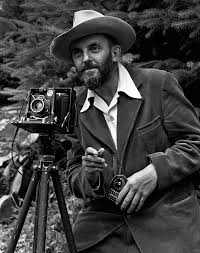
Show Up, Speak Up, Don’t Give Up

Ansel Adams’ “Monolith—the Face of Half Dome” (shot in Yosemite National Park)
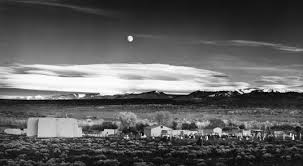
“Moonrise, Hernandez, New Mexico” captured by Ansel Adams
Even if you can’t name many famous photographers, you’ve probably heard of Ansel Adams. While this celebrated nature photographer was a San Francisco native, I believe Adams had the heart of a farmer. His work offers insights on how we can be more effective “ag-vocates.” Actually, his example will resonate with any of you who have a cause you’re passionate about.
I’ve become more familiar with Adams, a pioneer in America’s conservation movement, through a photography class I’m taking at Reiman Gardens in Ames. Adams viewed nature as precious and wanted to give conservation greater value in society. His stunning black and white landscape photographs of the American West portray this spirit.
Adams’ work also reflects the countless years he spent studying the places he photographed. It’s clear his iconic images like “Monolith—the Face of Half Dome” (shot in Yosemite National Park) and “Moonrise, Hernandez, New Mexico” were captured at the precise moment when the image would capture the most beauty and convey the greatest emotional impact.
Adam’s unforgettable images reflect the soul of someone who was intimately familiar with the region’s weather patterns. Someone in tune with the rhythms of nature. Someone who cherished the land and pondered people’s relationship to the land.
Sounds like an Iowa farmer to me.
Just as Adams’ photography forever changed how people view nature, we, too, can influence how people perceive farmers and our relationship to the land. Here are three tips to get started:
1. Show up. Like Adams, who returned time and again to photograph the places he loved, ag-vocates must show up. Never forget the wisdom of filmmaker Woody Allen, who noted that “80 percent of success is just showing up.” Good places to start are local grassroots organizations like the Iowa Corn Growers Association, the local county Farm Bureau, Iowa Soybean Association, Iowa Cattlemen’s Association, Iowa Pork Producers Association, Iowa Turkey Federation, Practical Farmers of Iowa or other ag groups. Don’t stop with your membership. Be willing to volunteer and serve in leadership positions, too. Everyone, including you, has something of value to give.
2. Speak up. Adams used his compelling visual images to speak up for the things he held dear in life. If you take photos of life on the farm, you don’t have to be the next Ansel Adams before you share your images on social media, at the county fair, etc. Not a photographer? Use your voice to write letters to the editor on timely topics affecting agriculture. Speak up at meetings when ag issues are at stake. There’s a chance you may be one of the few voices sharing agriculture’s perspective, which makes your message even more essential. Last summer I attended a gathering near Redfield where Bill Stowe of the Des Moines Water Works spoke about how farmers are ruining Iowa’s water quality. I knew I was one of the few farmers in the group of about 30 people, but I stood up, introduced myself and challenged some of his assumptions as I explained the conservation practices on my family’s Century Farm in Calhoun County and told how we received an Iowa Farm Environmental Leader Award at the 2016 Iowa State Fair. While I was scared to share my story at first, I was surprised to receive a round of applause from the group.
3. Don’t give up. Adams, who died in 1984, spent a lifetime portraying his philosophical vision of the land and people’s relationship to it. Just like Adam’s work, ag-vocating isn’t a once-and-done job. It requires patience and persistence. By showing up, speaking up and not giving up, you, too, have the power to leave a legacy that forever changes the way others view the world.
This originally appeared in my column in June 2017 in Farm News.
Want more?
Thanks for stopping by. I invite you to read more of my blog posts if you want more more intriguing Iowa stories and history, along with Iowa food, recipes and tips to make you a better communicator. If you like what you see and want to be notified when I post new stories, be sure to click on the “subscribe to blog updates/newsletter” button at the top of this page. Feel free to share this information with friends and colleagues who might be interested, too.
If you’re hungry for more stories of Iowa history, check out my top-selling “Culinary History of Iowa: Sweet Corn, Pork Tenderloins, Maid-Rites and More” book from The History Press, as well as my Calhoun County” book from Arcadia Publishing, which showcases the history of small-town and rural Iowa. Order your signed copies today! Iowa postcards are available in my online store, too.
Let’s stay in touch. I’m at darcy@darcymaulsby.com, and yettergirl@yahoo.com.
About me:
Some people know me as Darcy Dougherty Maulsby, while others call me Yettergirl. I grew up on a Century Farm between Lake City and Yetter and am proud to call Calhoun County, Iowa, home. I’m an author, writer, marketer, business owner and entrepreneur who specializes in agriculture. Learn more at www.darcymaulsby.com.
P.S. Thanks for joining me. I’m glad you’re here.
@Copyright 2017 Darcy Maulsby & Co.
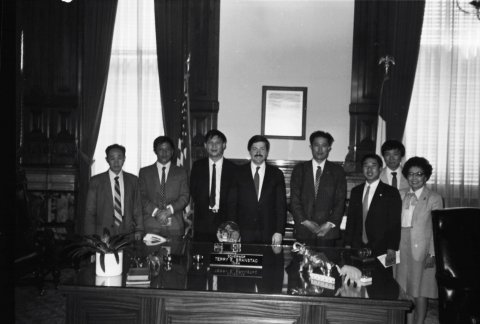
Remembering Ambassador Branstad’s Legacy from the 1980s Farm Crisis in Iowa
A morning talk-show host on WHO Radio in Des Moines posed an interesting question when former Iowa Governor Terry Branstad was confirmed as the U.S. ambassador to China on May 22, 2017. The broadcaster asked what might define Branstad’s enduring legacy, and he suggested it may be Branstad’s service during the 1980s Farm Crisis.
The more I thought about it, the more I agreed. I was just a kid in the 1980s Farm Crisis and didn’t really understand what was happening, but I knew it was bad. I remembering writing a poem about the Farm Crisis in 7th grade in 1987 for my contribution for a time capsule that was buried in Lake City.
Sheltered as I was from my family’s financial realities, I had no idea my dad only made $800 one year during the peak of the Farm Crisis. Still, that was far better than what some other farmers were experiencing. As one farmer told me during a recent interview about his family’s Century Farm, the thing he dreaded the most during the Farm Crisis was the phone ringing. “You never knew who it might be or what bad news it might be,” he said.
The Farm Crisis was just starting its brutal transformation of Iowa agriculture when Terry Branstad was first elected governor of Iowa in 1982. This new era was a far cry from the heady go-go days of the 1970s, when agriculture was booming, and making good money in farming was not only possible, but almost easy.
Farmers were hurting
By the early 1980s, however, a combination of national and international factors, including a Federal Reserve Board policy of high interest rates to fight inflation and a grain embargo against the Soviet Union, devastated the farm economy. Crop prices to dropped below the cost of production. Land values plummeted. Countless rural Iowa banks closed.
“All of us who lived in Iowa at the time saw friends and neighbors lose their family farms and struggle with what to do next to earn a living,” said Iowa Sen. Charles Grassley, who recalled the Farm Crisis in a 2015 press release he issued about Branstad becoming the longest-serving governor in the nation’s history.
By the time Branstad took office as governor, individual farmers across the state were hurting. No one really wanted to believe it was as bad as it was, but agriculture was in serious trouble.
In early December 1985, an eastern farmer who was apparently distraught over his finances killed the president of his bank, his neighbor and his own wife before he killed himself. Dale Burr, 63, who farmed near Lone Tree, made national headlines after he walked into the Hills Bank and Trust Company and shot its president, John Hughes, with a 12-gauge shotgun.
With farmers in desperate need of help, the Iowa governor’s office created the Rural Concern Hotline to provide assistance where possible. The state tried to help producers with debt restructuring as much as it could.
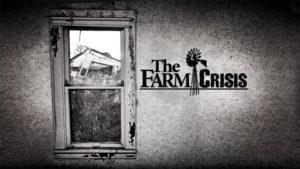 As the Farm Crisis deepened by the mid-1980s, however, one of the biggest frustrations was the seeming indifference from officials in Washington, D.C. “President Reagan was very supportive and sympathetic,” Branstad recalled in an Iowa Public Television documentary about the Farm Crisis. “Unfortunately, David Stockman, who worked for him and who was the director of the Office of Management and Budget, was pretty cavalier in his attitude. Considering all the stress and challenges we were going through in Iowa, we didn’t just take no for an answer.”
As the Farm Crisis deepened by the mid-1980s, however, one of the biggest frustrations was the seeming indifference from officials in Washington, D.C. “President Reagan was very supportive and sympathetic,” Branstad recalled in an Iowa Public Television documentary about the Farm Crisis. “Unfortunately, David Stockman, who worked for him and who was the director of the Office of Management and Budget, was pretty cavalier in his attitude. Considering all the stress and challenges we were going through in Iowa, we didn’t just take no for an answer.”
Hollywood goes to Congress, Branstad creates a new environment for business
Even Hollywood took note. Two popular films, Country and The River, drew the eyes of America to the plight of the nation’s farm families. Soon, Hollywood stars like Jessica Lange were testifying before Congress about the Farm Crisis.
Far from Congress and Hollywood, however, Branstad relied on his small-town and farm background to lead Iowa through the Farm Crisis.
“The state needed men and women with vision and ambition to pull the economy out of the doldrums,” Grassley noted. “It needed people who could see the potential for farmers to add value to their operations and for Iowa to diversify its economy. Terry Branstad was one of those people.”
Branstad was at the forefront of creating a new environment to do business. He welcomed and actively encouraged innovation that would capitalize on Iowa’s bedrock work ethic and strong schools. As a result, agriculture continues to be a mainstay of the Iowa economy while providing the economic engine that benefits many other employment sectors, including renewable energy, manufacturing, crop research and much more.
Ironically, some of Branstad’s actions in the Farm Crisis didn’t seem that significant at the time but would benefit agriculture decades in the future. In 1985, while still in his first term as governor, Branstad welcomed Xi Jinping, who was then a Communist party official and feed cooperative director from Hebei Province. Xi Jinping, who is now the president of China, spent several days in Muscatine in 1985 leading a delegation of Chinese government officials who saw Iowa agriculture first-hand and became acquainted with Iowa farm families.
That visit 32 years ago forged an unlikely bond between China and rural Iowa that endures today. I believe this bodes well for rural Iowa and our role in the global economy as Branstad serves as America’s ambassador to China.
It’s also a large feather in the cap of an Iowa farm kid from Leland, population 284, whose legacy as Iowa’s governor and ambassador to China can’t be told accurately without looking back to those painful, pivotal days of the 1980s Farm Crisis.
Want more?
Thanks for stopping by. I invite you to read more of my blog posts if you want more more intriguing Iowa stories and history, along with Iowa food, recipes and tips to make you a better communicator. If you like what you see and want to be notified when I post new stories, be sure to click on the “subscribe to blog updates/newsletter” button at the top of this page. Feel free to share this information with friends and colleagues who might be interested, too.
Let’s stay in touch. I’m at darcy@darcymaulsby.com.
P.S. Thanks for joining me. I’m glad you’re here.
@Copyright 2017 Darcy Maulsby & Co.
About me:
Some people know me as Darcy Dougherty Maulsby, while others call me Yettergirl. I grew up on a Century Farm between Lake City and Yetter and am proud to call Calhoun County, Iowa, home. I’m an author, writer, marketer, business owner and entrepreneur who specializes in agriculture. Learn more at www.darcymaulsby.com.
This column first appeared in Farm News in June 2017.
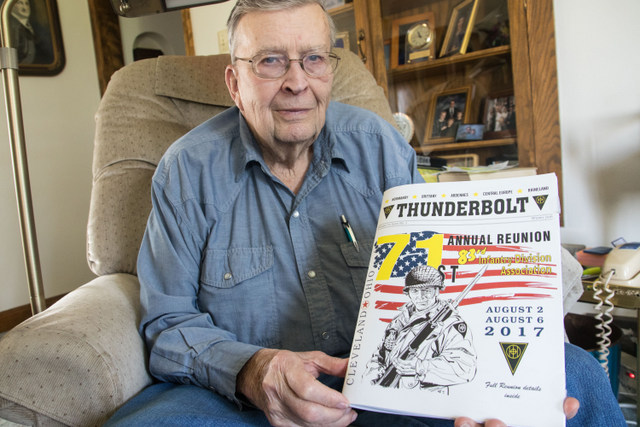
“Thank God It’s Over:” Iowa Veteran Recalls the Final Days of World War 2
While V-E Day (Victory in Europe) was proclaimed “the celebration heard ‘round the world,” it was only a temporary reprieve for Harold Geisinger. This 19-year-old Iowa farm boy from Storm Lake was on his way to Le Havre, France, with the U.S. Army when Germany surrendered unconditionally to the Allies on May 7, 1945.
After a low-key celebration, Geisinger and his fellow soldiers boarded a box car in France bound for Hanover, Germany. Geisinger then joined a convoy in Bavaria, the section of Germany where American troops were guarding railroads, train depots, irrigation sites and more.
While the war was over in Europe, fighting continued on the other side of the globe. In the summer of 1945, there was talk that Geisinger and his fellow soldiers would likely be on board the next U.S. military ship bound for the Pacific Theater. Everything changed, however, when Japan surrendered on Sept. 2, 1945, following President Harry S. Truman’s orders to drop two atomic bombs on Japan in August 1945.
“When we got the word that Japan quit, we didn’t celebrate,” said Geisinger, 91, who still gets tears in his eyes when he thinks back to those days nearly 72 years ago. “We simply sat down and said, ‘Thank God it’s over.’”
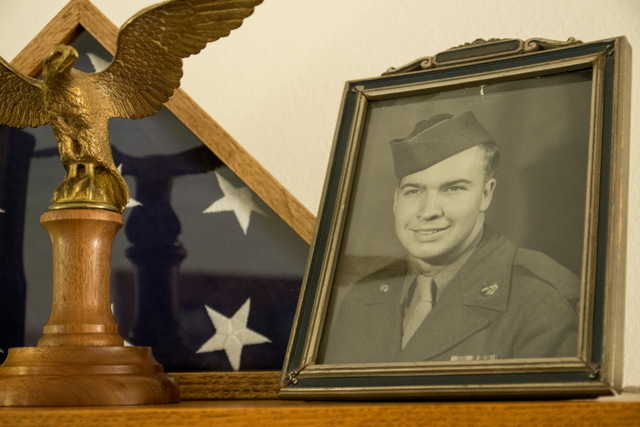
After graduating from Storm Lake High School in 1944, Harold Geisinger was drafted into the U.S. Army on Aug. 2, 1944. “Back then, we all wanted to serve,” he said.
Battle of the Bulge put Geisinger on the fast track
As a World War 2 veteran, Geisinger is becoming a rare breed. Only 620,000 of the 16 million Americans who served in World War II were alive in 2016, according to U.S. Department of Veterans Affairs statistics.
Like many members of the Greatest Generation, Geisinger’s life would never be the same after Japan attacked Pearl Harbor on December 7, 1941. “I was walking up the steps of our house and the radio was on,” said Geisinger, who stills lives in this house on the north edge of Storm Lake. “That’s when I heard the news about Pearl Harbor.”
After graduating from Storm Lake High School in 1944, Geisinger was drafted into the U.S. Army on Aug. 2, 1944. “Back then, we all wanted to serve,” he said.
Following 17 weeks of basic training in Arkansas, things moved quickly for Geisinger. “As my basic training was ending, the Battle of the Bulge was beginning, so the Army fast tracked us,” said Geisinger, who left on Christmas Day 1944 for Camp Myles Standish in Massachusetts. This U.S. Army camp functioned as a departure area for thousands of U.S. soldiers during World War 2.
In mid-December 1944, Germany had launched its last major offensive and intended to split the Allied armies. This surprise blitzkrieg in northwest Europe, which became known as the Battle of the Bulge, did not turn the tide of the war in Adolph Hitler’s favor but did result in American and civilian casualties.
The Battle of the Bulge was still raging when Geisinger shipped out for Europe on January 2, 1945. “I was on my two-week ‘ocean cruise,’” said Geisinger, who had turned 19 just a few days earlier on Christmas Eve.
When Geisinger and his fellow soldiers with the Army’s 83rd Infantry Division, Company I, arrived at Le Havre, France, they were transferred to railroad box cars bound for Givet, a small community in the north of France, near the Belgian border. “These box cars were called ’40 by 8s,’ meaning they could hold 40 men or 8 horses,” said Geisinger, who recalled that it was close to a month after he left America before he had the chance to take a real shower—not just a saltwater shower on the ship.
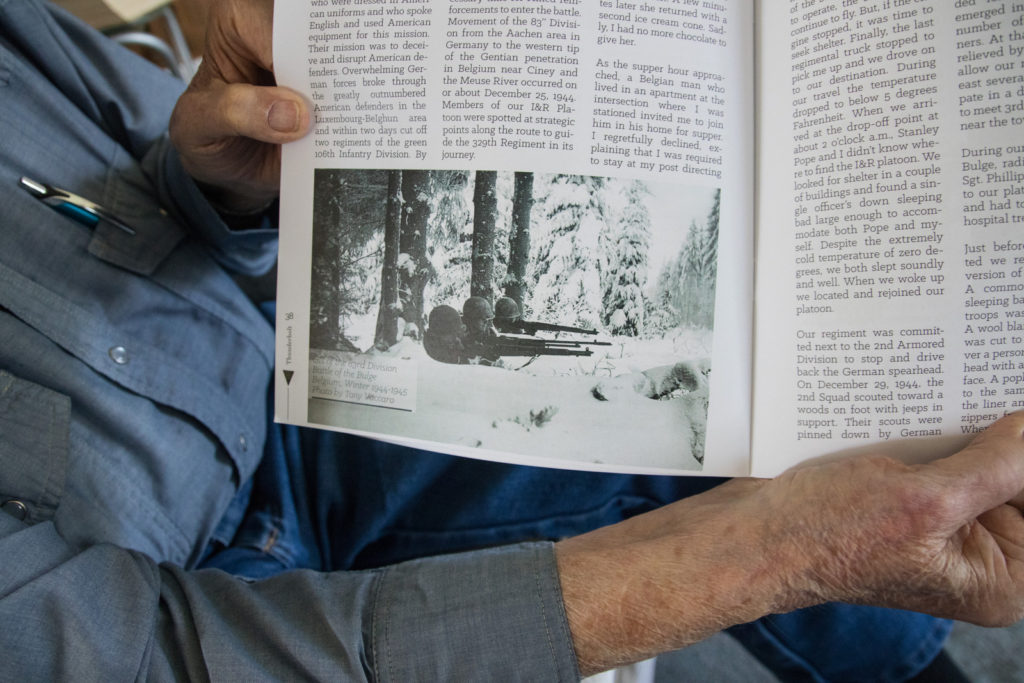
The Battle of the Bulge was still raging when Harold Geisinger shipped out for Europe on January 2, 1945. Geisinger and his division spent most of their time training in the Hürtgen Forest, located along the border between Belgium and Germany. “Our division was preparing to push across Germany,” Geisinger said.
Much worse than the shower situation, however, were the frigid January temperatures and lack of adequate overshoes during the box car ride. “I froze my feet,” Geisinger recalled.
After reaching their destination, Geisinger and his division spent most of their time training in the Hürtgen Forest, located along the border between Belgium and Germany. “Our division was preparing to push across Germany,” Geisinger said.
In the meantime, however, Geisinger was waging his own battle with a cough that wouldn’t go away. The coughing became severe that he couldn’t eat. On Feb. 14, 1945, he had to go on sick call and was diagnosed with viral pneumonia. Geisinger returned to France and was transferred to a hospital in southern England at Newton Abbot. “I was there two months with no medicine,” said Geisinger, who eventually recovered and returned to active duty.
In early May 1945, Geisinger was crossing the English Channel in a ship bound for Le Havre, France, when he heard the news that Germany had surrendered. Although Hitler and the Nazis had been defeated, Geisinger knew he wouldn’t be returning home to northwest Iowa anytime soon. After boarding another box car, Geisinger headed to Bavaria to rejoin Company I and the men he had served with before.
Everyone wondered if they’d be called to fight the war in Japan. “Had we shipped out, some said we would have left from Marseille in southern France and sailed around Cape Horn and onto Japan,” Geisinger said. “When I heard that Japan surrendered, I kept thinking, ‘Someday we’ll get to go home.’”
Transitioning from solider to farmer
That day wouldn’t come for months, however. Geisinger remained in Europe and remembers pulling guard duty along the Danube River. He crossed the river with a buddy one night to meet Russian soldiers on the other side.
“We drank a little beer with a Russian sergeant and tried to communicate using hand signals and the little bit of German we and the Russian had picked up,” Geisinger said. “The one thing the Russian sergeant wanted was American uniforms. He wanted all the American uniforms he could get.”
Geisinger couldn’t access any uniforms other than the one he was wearing. He had no idea why the sergeant wanted American uniforms, although he later suspected an ulterior motive. “I assumed it was for infiltration,” said Geisinger, whose distrust of the Russian sergeant proved accurate as the Cold War heated up.
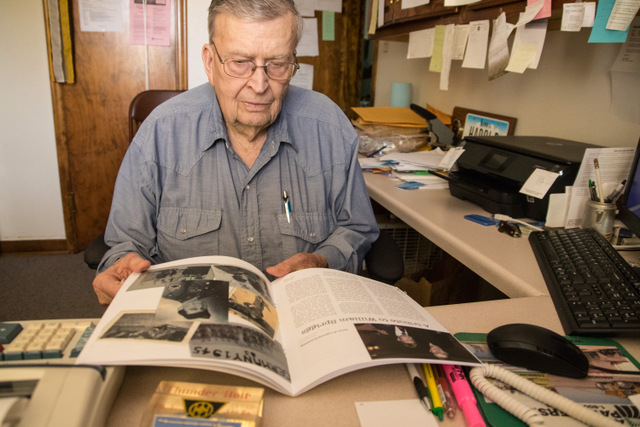
As he sits in his home office, Harold Geisinger looks through pieces of the past, including World War 2 history books.
By the time Geisinger was honorably discharged from the Army, he had achieved the rank of corporal. He looked forward to returning to Storm Lake to farm and finally reached home in July 1946. By then, agriculture had entered a new era as the transition to mechanical horsepower from traditional horsepower became complete. New equipment like combines also became more common in row-crop production.
Geisinger started farming with his father, L.J. Geisinger, on the Washington Township farm north of Storm Lake that had been in their family since 1915. Geisinger also used the G.I. Bill to earn his pilot’s license and enjoyed flying for many years.
Geisinger and his wife, Laura May, a Storm Lake High School classmate, raised their three children on the farm, along with corn, soybeans, hay, cattle and hogs. Farming still interests Geisinger, who helps run the field cultivator in the spring and helps combine in the fall. “I even planted some beans this spring,” said Geisinger, who is proud of the rich heritage of his family’s Century Farm in Buena Vista County.
For decades, Geisinger served as a rifleman in the color guard unit in Alta (VFW Post 6172). While he has retired from these duties, his memories of World War 2 remain vivid, and he’s proud he was able to serve his country.
“My military experiences gave me more of global view of the world,” Geisinger said. “Even though a lot has changed since World War 2 and America has its deficiencies, I don’t know of a better place to call home.”
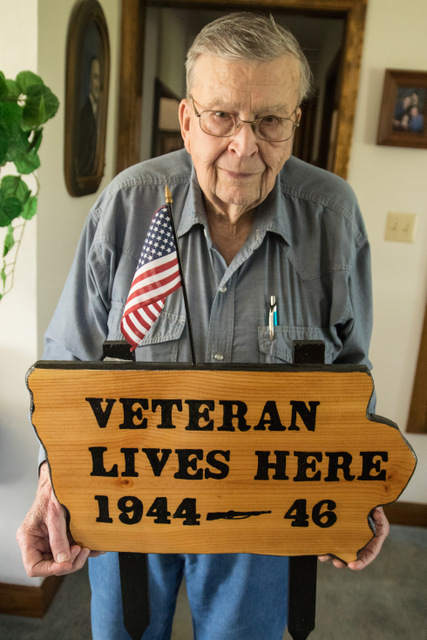
Harold Geisinger’s memories of World War 2 remain vivid, and he’s proud he was able to serve his country.
It was truly an honor to meet Harold Geisinger in May 2017 and interview him at his home and at his family’s farm north of Storm Lake, Iowa. He is a living legacy of America’s Greatest Generation. I’m forever grateful that Harold and hundreds of thousands of others like him were willing to serve. I’m also thankful he was willing to share his stories with me so I can share them with you. (I originally wrote this article for the Memorial Day 2017 of Farm News.)
Want more Iowa culture and history?
I invite you to read more of my blog posts if you want more Iowa stories, history and recipes, as well as tips to make you a better communicator. If you like what you see and want to be notified when I post new stories, be sure to click on the “subscribe to blog updates/newsletter” button at the top of this page. Let’s stay in touch.
Also, if you enjoyed Harold’s military story, be sure to check out my Memorial Day 2017 post on “How to Thank Veterans for Their Service.” I interviewed two recently-retired U.S. Marines from the Wounded Warrior Battalion, and their insights are invaluable.
If you’re hungry for more stories of Iowa history, check out my top-selling “Culinary History of Iowa: Sweet Corn, Pork Tenderloins, Maid-Rites and More” book from The History Press, as well as my Calhoun County” book from Arcadia Publishing, which showcases the history of small-town and rural Iowa. Order your signed copies today! Iowa postcards are available in my online store, too.
P.S. Thanks for joining me. I’m glad you’re here.
@Copyright 2017 Darcy Maulsby & Co.

Harold Geisinger served with the U.S. Army’s 83rd Infantry Division, Company I,
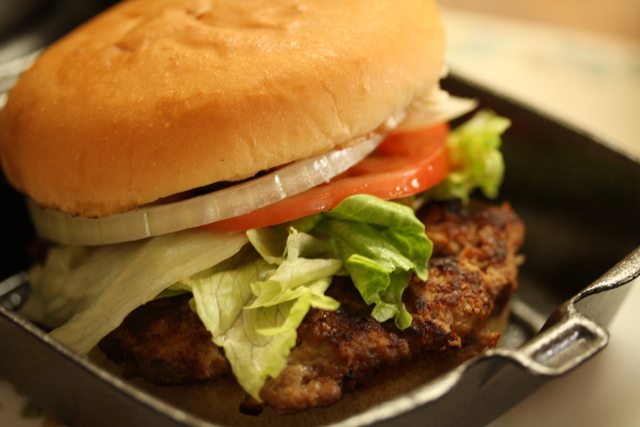
Get Your Grill On: How to Build a Better Burger
Love the thrill of the grill? I sure do, especially when I’m crafting a thick, juicy burger I can sink my teeth into. While we talk a lot about burgers during May Beef Month, how much do you really know about this American icon?
The classic hamburger we know and love today is very much an American invention. Stemming from German culinary roots, the burger-on-a-bun phenomenon gained widespread fame at the 1904 St. Louis World’s Fair.
Disaster struck two years later, however, when Upton Sinclair’s novel “The Jungle” (remember the book’s lurid details from high school literature class?) detailed the unsavory side of the American meatpacking industry. Ground beef became a prime suspect, since it could easily be adulterated with questionable additives.
The hamburger might have faded away as a long-forgotten fad were it not for Edgar Ingram and Walter Anderson. When they opened their first White Castle restaurant in Kansas in 1921, White Castle countered the hamburger’s unsavory reputation by becoming bastions of cleanliness, health and hygiene. This paved the way for national hamburger chains founded in the post-World War II boom years, including McDonald’s.
Best burgers, Iowa style
Iowa has made its own distinctive contributions to America’s burger history. Consider the wildly popular Iowa’s Best Burger contest, sponsored by the Iowa Cattlemen’s Association (ICA) and the Iowa Beef Industry Council (IBIC). Iowans submitted more than 9,200 nominations for this year’s contest. Nearly 500 Iowa restaurants were represented in 2017 in the total nominations, setting a new record for the contest.
As a former judge of Iowa’s Best Burger contest, I can tell you how tough it is to pick a winner. Iowans know how to make bodacious burgers, a story I made sure to include in my “Culinary History of Iowa” book.
Size matters when it comes to the Gunderburger at the Irish Shanti, which made the 2017 Top 10 list. The famous Gunderburger started in the late 1970s to put the tiny northeast Iowa community of Gunder on the map. The first Gunderburgers were a smaller version of the one served today. As the Gunderburger started growing in size in the 1990s, its notoriety also grew.
Another 2017 Top 10 Best Burger in Iowa contender is the Ankeny Diner, which offers Maytag Burgers, featuring Iowa’s famous Maytag blue cheese, sautéed onion and Monterey jack cheese. Don’t care for blue cheese? Maybe you’d prefer the Rarebit Burger, served open-faced and topped with spicy Cheddar cheese sauce.
Rarebits were legendary at the iconic Younkers Tea Room in downtown Des Moines for decades. An Iowa-style rarebit burger elevates the traditional Welsh rarebit, which incorporates leftover bits of cheese and the end-of-the-loaf slices of stale bread for a quick supper.
Speaking of Des Moines, the historic East Village is the home of the incomparable Zombie Burger. A previous Top 10 Best Burger in Iowa contender, Zombie Burger serves “gore-met” creations made from the shop’s own custom three-cut beef burger blend. With locations in downtown Des Moines, Ankeny, West Des Moines and the Iowa City area, Zombie Burger is distinguished by classics from the Undead Elvis (a burger paired with peanut butter, fried bananas, bacon, American cheese and mayo) to the Walking Ched (a burger featuring bacon, Cheddar cheese, caramelized onions and mayo on a deep-fried macaroni-and-cheese bun).
Hungry yet?
If all this inspiration has you craving top-quality, Iowa beef, here are my top tips to make your best burgers ever:
• Choose fresh 80/20 ground beef, which provides enough fat to keep your burgers juicy and flavorful.
• Worcestershire sauce adds a whole new depth of flavor to burgers. Add in a healthy dollop and mix it into the meat before forming the patties.
• Use your thumb to create a dimple or well in the center of each patty on the bottom. This helps ensure that the burgers cook evenly. Don’t worry—the indentation will hardly be noticeable by the time the burgers are ready.
• Cook your burgers over medium heat.
• As the patties cook, sprinkle them liberally on both sides with a mixture of salt, fresh-ground pepper, Lawry’s seasoning salt, garlic powder and onion powder.
• Avoid using your spatula to press down on your burgers while cooking. Don’t let all those flavorful juices escape.
• Allow your burgers to rest for a few minutes before serving. This will ensure that the juices redistribute into the meat. Enjoy!
Have any favorite burger recipes or cooking tips? I’d love to hear them. Now go get your grill on!
Hungry for more?
Want more burger inspiration? Check out my blog post on the Lake City Drive-In, where owner Larry Irwin is not only a beef booster, but someone who sees burgers as the perfect palette for culinary creativity with his Burger of the Month flavors. (Don’t miss my recipe for Meatloaf Burgers!)
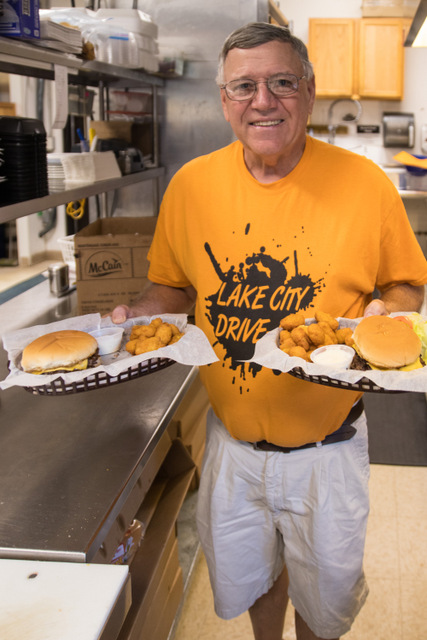
Larry Irwin shows off some tasty burgers from the Lake City Drive-In.
If you’re hungry for more stories of Iowa history, Larry is kind enough to carry my books at the Lake City Drive-In. Not close to Lake City? I invite you to visit my online store, where you can purchase my top-selling “Culinary History of Iowa: Sweet Corn, Pork Tenderloins, Maid-Rites and More” book from The History Press, as well as my “Calhoun County” book from Arcadia Publishing, which showcases the history of small-town and rural Iowa. Order your signed copies today! Iowa postcards are available in my online store, too.
One more thing–check out more of my blog posts if you want more Iowa stories, history and recipes, as well as tips to make you a better communicator. If you like what you see and want to be notified when I post new stories, be sure to click on the “subscribe to blog updates/newsletter” button at the top of this page. Let’s stay in touch!
This originally appeared as one of my weekly columns in Farm News.
P.S. Thanks for joining me. I’m glad you’re here.
@Copyright 2017 Darcy Maulsby & Co.
